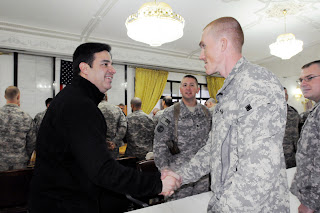By Staff Sgt. April Davis, 116th Garrison Command, USD-C
BAGHDAD—U.S. Rep. Raul Labrador, R-Idaho, visited Soldiers with the 116th Cavalry Brigade, Idaho Army National Guard, based out of Boise, Idaho, Feb. 2 at Camp Victory in Baghdad, Iraq. The brigade is currently serving as Garrison Command for Victory Base Complex under United States Division – Center in support of Operation New Dawn.
“Meeting with Soldiers has been the best part of the whole trip,” Labrador said. “There’s nothing better than being with the men and women from Idaho
Soldiers from the 1st Congressional District of Idaho, serving with the 116th Cavalry Brigade’s 2nd Squadron, 116th Cavalry Regiment and 145th Brigade Support Battalion, also attended the dinner to meet their U.S.
“I learned more about my representative and his political stances than I knew before meeting him,” said Staff Sgt. Breane Buckingham, a supply sergeant with B Company, 145th BSB, and Coeur d’Alene , Idaho
This was Labrador ’s first visit to Iraq
“I’ve never served in the military, so seeing all the men and women that are here sacrificing their lives, giving up their time, being away from their family…I can’t even imagine what it’s like to be gone for such a long period of time serving your country and I’m going to take those thoughts back home with me,” he said. “Every time we’re thinking about sending someone to combat, this experience is going to be deeply ingrained in me.”
“I want the family members to know that their Soldiers are doing really great work and they should be really proud of what they do,” he said. “I haven’t been more proud of my country than I am today.”
Other Soldiers in attendance at the dinner included Maj. Paul White, of Eagle, Idaho, executive officer, and Command Sgt. Maj. William Coggins, of Nampa, Idaho, senior enlisted advisor, both with Headquarters and Headquarters Troop, 2nd Sqdrn., 116th Cav. Regt.; 2nd Lt. Travis Hight, of Lewiston, Idaho, Spc. Joel Eggert, of Moscow, Idaho, and Spc. Matthew Hoefling, of Post Falls, Idaho, all with B Co. 145th BSB.
U.S. Rep. Raul Labrador, R-Idaho, (left) meets Spc. Matthew Hoefling (right), a Post Falls, Idaho native, with B Company, 145th Brigade Support Battalion, 116th Cavalry Brigade, Feb. 2 at Camp Victory in Baghdad. Labrador took time out of his schedule, assessing U.S. government spending in Iraq, to have dinner with Idaho Army National Guard Soldiers from his congressional district who are currently serving under United States Division – Center in Support of Operation New Dawn. (U.S. Army photo by Staff Sgt. April Davis, 116th Garrison Command, USD-C)
U.S. Rep. Raul Labrador, R-Idaho, (left), Maj. Paul White (center), executive officer of 2nd Squadron, 116th Cavalry Regiment, and an Eagle, Idaho resident, and Col. Guy Thomas (right), commander of the 116th Cavalry Brigade, and a Meridian, Idaho resident, discuss the diverse missions assigned to the brigade, Feb. 2, at Camp Victory in Baghdad. Labrador took time out of his schedule, assessing U.S. government spending in Iraq, to have dinner with Idaho Army National Guard Soldiers from his congressional district who are currently serving under United States Division – Center in Support of Operation New Dawn. (U.S. Army photo by Staff Sgt. April Davis, 116th Garrison Command, USD-C)






















